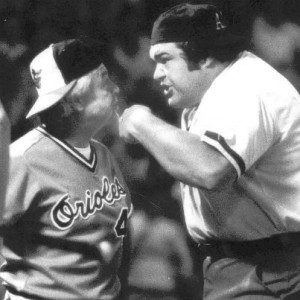
The Earl of Baltimore could have easily been the Earl of sabermetrics. Earl Weaver, who passed away Saturday at the age of 82, did things in the seventies that managers still aren’t doing. All his notes and stats were scribbled by hand on index cards, later to be sorted and stacked by a college intern. No iPads in those days. He took matchups seriously and used a player’s strength, based on his notes, to decide where in the lineup to place him.
He was the first to use on-base percentage to help evaluate hitters and would take interest in players who were as good at drawing walks as they were hitting the ball. Ironically, Weaver credits common sense for most of his managing success. More than likely, sabermetrics, which didn’t even exist then, were common sense for him.
Weaver valued the walk, not wasting an out, and the three-run homer. He believed the last position player on your bench will win you more games than the 10th pitcher in the bullpen. He didn’t believe in the fifth starter, small ball or stealing bases. I have heard so many quotes contributed to Earl Weaver that it’s overwhelming to sort through them, but here are a couple of the favorites:
- “If you play for one run, that’s all you’ll get.”
- “Momentum is tomorrow’s pitcher.” (This you hear every freaking day)
- “I’ve got nothing against the bunt, in its place. But most of the time that place is at the bottom of a long forgotten closet.”
- Once a player told Weaver it was great to walk with the Lord, Weaver said, “I’d rather you walk with bases loaded.” (My favorite)
There are so many umpire stories, we could go on forever. Weaver was thrown out between 90 and 100 times. There are varying numbers, but I think more than 50 ejections starts to be excessive; so, close to 100 is only something Weaver could pull off. He kicked dirt on umpires, turned his hat backwards to get even closer and ripped up rule books to get his point across. He would get thrown out before games started, at both ends of a doubleheader and he would question an umpire’s integrity to writers after games. He was suspended multiple times for his antics, and the league actually rearranged the Orioles schedule in order to keep Weaver from crossing paths with umpire Ron Luciano. When an umpire once offered Weaver his rule book, Earl said, “That’s no good, I don’t read Braille.”
The American League actually changed the DH rule directly relating to Weaver. He would pencil in pitcher Steve Stone as his DH every game. The idea was, he would pinch hit for Stone depending on the matchup. Baseball, however, inserted a rule stating a DH in the starting line up has to bat at least one time.
I really could go on about the Earl of Baltimore. Four pennants, one World Series, a Hall of Fame induction and retired with a .583 winning percentage. He co-authored the book Weaver on Strategy, and in 1987, a successful video game’s AI was modeled after his managing strategy. Earl Weaver’s Baseball was a full-on baseball simulation that made it into the Computer Game Hall of Fame.
I grew up listening to my grandfather scream at Weaver through the TV and radio, sometimes at the same time. My grandmother would drive from store to store looking for Weaver’s commercially available tomato plant fertilizer; in other words, he was incredibly important in Baltimore’s day to day life. He was honored with a statue at Camden Yards last season and, thankfully, got to see the Orioles finally have another winning season.
We lost him early Saturday morning, while on an Orioles Fantasy Caribbean cruise.
Rest in peace, Earl of Baltimore. Hopefully you’ll get your wish, and your tombstone will read: “The sorest loser who ever lived.”
